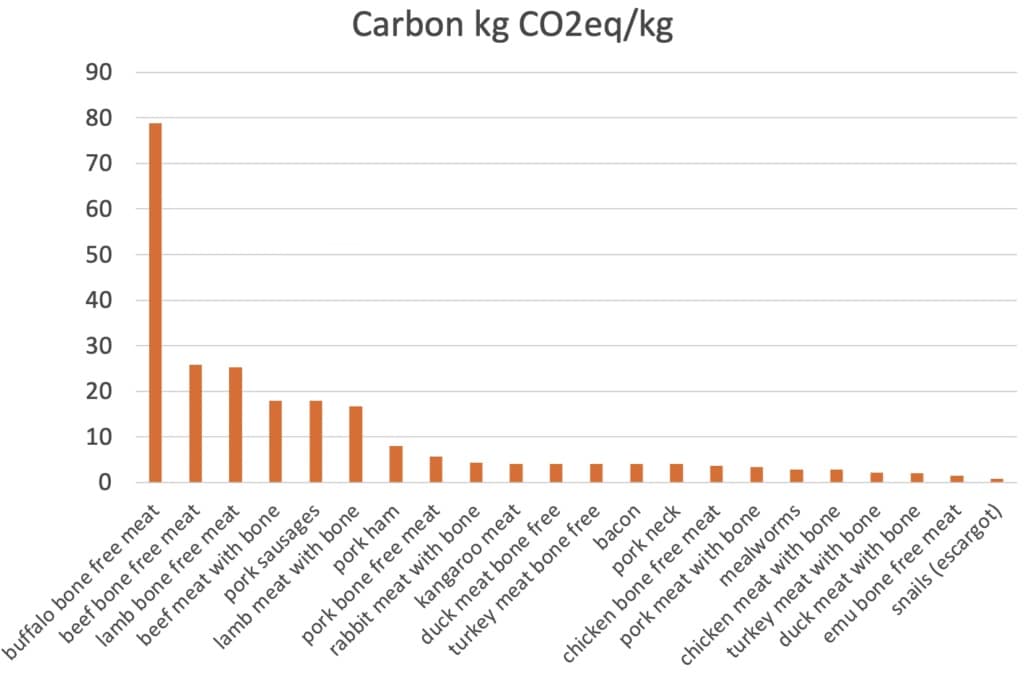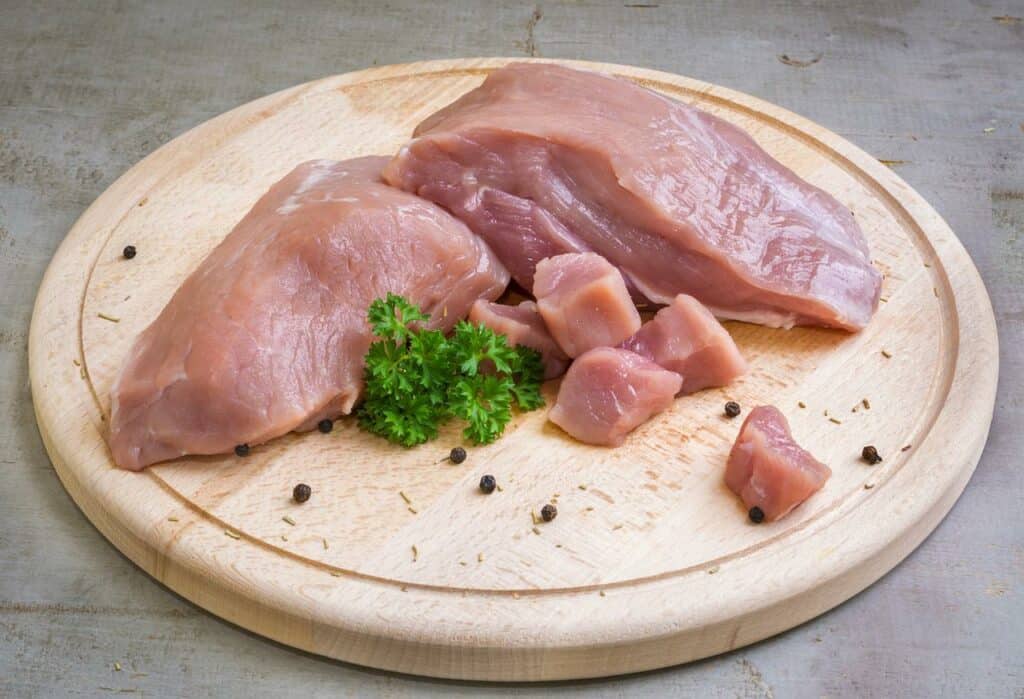The Most Environmentally Friendly Meat: Choosing Your Options
What meat impacts the environment least? The answer may surprise you! In fact, the question may even be posed differently. One meat is the absolute worst, and picking anything else is enough to reduce carbon greatly.

[Update: we updated this article by switching our numbers to a study by Petersson and Castaldi that is more comprehensive and has more sources of meat]
Top 3 Least Carbon Intensive Meats
1. Snail (escargot)
Snails (escargot) hold the title for the least carbon-intensive item in the table, with a value of 0.73 kg CO2eq/kg.
The farming of snails, or heliciculture, is very resource efficient per kg of meat recovered, requiring significantly less land and feed than traditional livestock.
2. Turkey and Duck
The meat from turkey and duck with bone follow closely behind snails, with carbon footprints of 2.13 and 2.07 kg CO2eq/kg respectively.
These meats are less carbon-intensive, likely due to more efficient feeding and growth rates in these birds compared to larger mammals.
3. Chicken
Chicken, probably the most well-known to readers, in particularly chicken meat with bone, also has a very low carbon intensity, at 2.82 kg CO2eq/kg.
This is mainly due to chickens’ efficient conversion of feed into meat, which requires less resources compared to larger livestock.
They grow quickly, require less land, and emit less methane, thereby reducing their overall carbon footprint.
Chicken is also one of the most accessible and versatile meats globally, due to its affordability and ease of preparation in a variety of dishes.
Full Chart Of Meat Carbon Intensity

Top 3 Most Carbon Intensive Meats
1. Buffalo bone free meat
Buffalo bone free meat is the most carbon-intensive food item on the list, with a carbon intensity of 78.80 kg CO2eq/kg.
The production of buffalo meat requires substantial amounts of feed and the animals produce significant methane emissions.
Land use changes associated with buffalo farming, such as deforestation for grazing pastures, further contribute to its high carbon footprint.
2. Beef bone free and with bone
Beef bone free meat and beef meat with bone follow buffalo, having carbon footprints of 25.75 kg CO2eq/kg and 17.96 kg CO2eq/kg respectively.
Beef production is known for its substantial environmental impact due to factors like land use, water use, and greenhouse gas emissions.
It is one of the most resource-intensive types of meat to produce.
3. Lamb
Lamb meat, whether bone-free or with bone, has a significant carbon intensity, with 25.23 kg CO2eq/kg for bone-free and 16.70 kg CO2eq/kg for lamb with bone.
This high footprint is attributed to several factors. methane produced during their digestion process, low meat yield per animal, and raising in pastoral systems that require vast amounts of land.
Table Of Values For carbon Intensity Of Meats
We reproduce the chart above with the numbers here:
| Food Item | Carbon kg CO2eq/kg |
| snails (escargot) | 0.73 |
| emu bone free meat | 1.5 |
| duck meat with bone | 2.07 |
| turkey meat with bone | 2.13 |
| chicken meat with bone | 2.82 |
| mealworms | 2.84 |
| pork meat with bone | 3.44 |
| chicken bone free meat | 3.68 |
| bacon | 4.03 |
| pork neck | 4.03 |
| turkey meat bone free | 4.08 |
| kangaroo meat | 4.1 |
| duck meat bone free | 4.1 |
| rabbit meat with bone | 4.31 |
| pork bone free meat | 5.72 |
| pork ham | 7.95 |
| lamb meat with bone | 16.7 |
| pork sausages | 17.94 |
| beef meat with bone | 17.96 |
| lamb bone free meat | 25.23 |
| beef bone free meat | 25.75 |
| buffalo bone free meat | 78.8 |
Data Is From A Large Scale Study By Petersson And Castaldi
The study “A multilevel carbon and water footprint dataset of food commodities” by Tashina Petersson and colleagues, published in Scientific Data in 2021, presents a comprehensive resource for understanding the environmental impacts of various food commodities.
The authors introduced the SU-EATABLE LIFE database, which comprises multilevel data on the carbon and water footprints of different food items (see more below).
The database is built on a standardized methodology that extracts information from peer-reviewed articles and grey literature to assign accurate and optimal footprint values and their associated uncertainties to food commodities.
This rigorous approach ensures the reliability of the database and its potential for further expansion. One of the key features of the study is its innovative methodological framework for managing uncertainty and assuring data quality.
This robust foundation enables an in-depth evaluation of how changes in dietary habits can influence global environmental policies, such as greenhouse gas emission reductions.
The database also serves as a reliable tool for researchers and managers in the food sector, offering a publicly available, trustworthy, and ready-to-use synthesis of the environmental pressures associated with food commodities.
The study aims to inform and engage citizens, prompting them to adopt more sustainable diets, thus reducing the global environmental impacts of the agricultural and food sectors.
In terms of measurements, the study looks at the carbon and water footprints of food products, along with the uncertainties related to these measures.
SU-EATABLE LIFE Project And Database
More broadly, SU-EATABLE is a three-year initiative aims to reduce both CO2 emissions and water usage in the European food chain, which accounts for about 30% of Europe’s CO2 emissions.
By promoting sustainable and healthy diets through engagement activities in university and company canteens in Italy and the UK, the project aims to save approximately 5,300 tons of CO2 equivalent and 2 million cubic meters of water.
Non-Meat Protein Alternatives Are Even Lower Carbon Intensity
Eggs, soy and nuts are all high protein substitutes and are plausible replacements. They have the additional benefit of being super low in carbon impact. 100g of nut protein generates less than 1 kg of CO2. Companies like Beyond Meat and Impossible Foods are manufacturing high end meat mimics. Recipes available online for free give instructions on making meat-free courses, which are substituted with mimics, a common one being chickpea-derived imitation meat.

Factors Of Environmentally Friendly Meat
The first is the impact of livestock farming on greenhouse gas emissions. Livestock farming accounts for 14.5% of global greenhouse gas emissions, making it a significant contributor to climate change.
The second thing to consider is the impact of livestock farming on water resources. It takes a lot of water to produce meat – for example, it takes around 15,000 liters of water to produce 1kg of beef.
The third thing to consider is the impact of livestock farming on biodiversity. Intensive livestock farming leads to habitat loss and the fragmentation of ecosystems.
Summary: Chicken, Poultry
As you can see, all poultry options have a significant impact on the environment.
If you are looking for the most environmentally friendly meat, chicken is probably your best option.
However, all poultry options hurt biodiversity, so if this is a key concern for you, you may want to choose another protein source altogether.
There are many factors to consider when trying to choose the most environmentally friendly meat.
The three main impact factors are greenhouse gas emissions, water use, and biodiversity. Of these, chicken has the smallest carbon footprint and requires the least amount of water per kilogram of meat produced.
Despite this, biodiversity is affected by any poultry alternative. If this is a major issue for you, you may want to consider switching to a different type of protein.
Rising Stars Of The Imitation Meat Industry: Cutting Carbon Without Compromising Flavor
Imitation meats or “plant-based meats” are not an entirely new phenomenon.
However, over the past few years, there’s been a wave of new entrants into this space, using innovative technologies to bring the consumer experience closer than ever to eating traditional meat.
These products offer an incredible promise: the taste and satisfaction of meat with a fraction of the carbon footprint.
One notable example is Impossible Foods, a company whose plant-based burgers have taken both restaurants and supermarkets by storm.
Using a molecule called heme, derived from genetically modified yeast and without using livestock, they’ve been able to reproduce the iron-rich taste that’s characteristic of beef.
Beyond Meat is another pioneer in this field, focusing on using pea protein to reproduce the texture and taste of meat products.
The Beyond Burger produces 90% fewer greenhouse gas emissions than a conventional beef burger, according to a life cycle assessment by the University of Michigan.
Making The Best Choice For You
There is a single worst choice – beef, which is fairly accessible.
This is because beef consumes vast amounts of energy and water to create on a per calorie basis compared to all other foods. On the other hand, there are many meats that are low impact environmentally.
Therefore there is no single “best” choice when it comes to meat.
Once you avoid beef, the important thing is to make a choice that aligns with your values. If you are concerned about the environment, choose meat that has a low impact on greenhouse gas emissions, water use, and land use.
